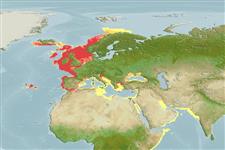Common names from other countries
Classification / Names / Names
ماع يماسا | فدارتم | Catalog of Fishes (gen., sp.) | ITIS | CoL | WoRMS
Environment: milieu / climate zone / depth range / distribution range
يسانش موب
; روش بل; قمع تارييغت 0 - 521 m (Ref. 108343). Temperate; 72°N - 12°N, 19°W - 62°E
Western Indian Ocean, Northeast Atlantic and the Mediterranean. Subtropical.
Length at first maturity / Size / Weight / نس
Maturity: Lm ? range ? - ? cm Max length : 2.5 cm SHL يسنج صاوخ نودب / رن سنج; (Ref. 7882)
Species' maximum length from the Belgian part of the North Sea (Ref. 7882). Inhabit sandbanks and inshore areas (Ref. 96352). Common in near-coastal zone, rarely further than 30 km off the coast. Found buried deep in almost all sediment types but prefer fine-grained to muddy substrates; rare in coarse substrates. Feeds through its long, individually separated and stretchable siphons (Ref. 7882). Known as a surface deposit feeder (Refs. 96214, 96292).
Life cycle and mating behavior
غولب | لثم دیلوت | یزیر مخت | اه مخت | Fecundity | )ورال ( دازوت
Members of the class Bivalvia are mostly gonochoric, some are protandric hermaphrodites. Life cycle: Embryos develop into free-swimming trocophore larvae, succeeded by the bivalve veliger, resembling a miniature clam.
یلصا ذخآم
عجارم | هدننك گنهامه | ناراكمه
Degraer, S., J. Wittoeck, W. Appeltans, K. Cooreman, T. Deprez, H. Hillewaert, K. Hostens, J. Mees, E. Vanden Berghe and M. Vincx. 2006. (Ref. 7882)
NCUI زمرق تسرهف رد تيعضو (Ref. 130435)
ستياس رظن زا تيعضو (Ref. 108899)
Not Evaluated
Not Evaluated
یناسنا هدافتسا
| FishSource |
اهرازبا
يتنرتنيا عبانم
Estimates based on models
Preferred temperature
(Ref.
115969): 6.7 - 13.1, mean 8.8 (based on 495 cells).
یگدنهج
دايز, هام 51 زا رتمك ، تيعمج ندش ربارب ود يارب مزال نامز هنيمك (K=1.22).
یريذپ بيسآ
Low vulnerability (10 of 100).
تميق هقبط
Unknown.
